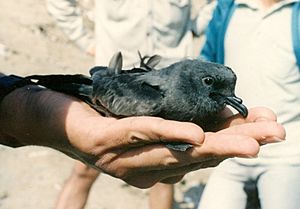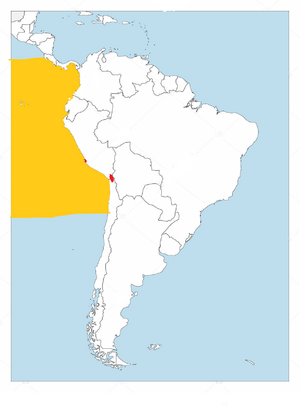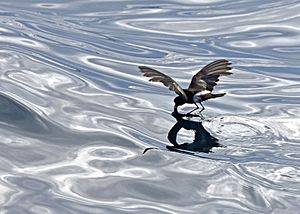Markham's storm petrel facts for kids
Quick facts for kids Markham's storm petrel |
|
|---|---|
 |
|
| Conservation status | |
| Scientific classification | |
| Genus: |
Hydrobates
|
| Species: |
markhami
|
 |
|
| Distribution: red = breeding, yellow = non-breeding | |
| Synonyms | |
|
List
Cymochorea markhami
Salvin, 1883 Oceanodroma markhami Salvin, 1883 |
|
The Markham's storm petrel (Hydrobates markhami) is a small, dark seabird. It belongs to the storm petrel family, Hydrobatidae. This bird is mostly black or dark brown. It can be hard to tell apart from other similar birds, like the black petrel.
Markham's storm petrels live in the open Pacific Ocean near Peru, Chile, and Ecuador. However, they only build their nests in northern Chile and Peru. In 2019, most known nesting places were found in the Atacama Desert. A British bird expert named Osbert Salvin first described this bird in 1883. It was named after Albert Hastings Markham, a naval officer who found one of these birds near Peru.
These storm petrels nest in natural holes in saltpeter (a type of salt). Each pair lays one egg per season. After the young birds hatch, they head to the sea. Sometimes, bright city lights can confuse or attract them, making it hard for them to find their way. Markham's storm petrels eat fish, cephalopods (like squid), and crustaceans (like crabs). A study in 2002 showed that about 10% of their diet comes from scavenging for food.
Since 2012, Markham's storm petrel has been listed as an endangered species in Chile. In 2019, the International Union for the Conservation of Nature (IUCN) said the bird was Near Threatened. This means it could become endangered if its nesting areas keep shrinking. Groups like the Servicio Agrícola y Ganadero (SAG) in Chile are working to protect these birds.
Contents
What is a Storm Petrel?
Storm petrels are a group of seabirds known for their long legs and how well they live in the ocean. Most of them live in the northern part of the world. Markham's storm petrel is part of the Hydrobates group. It is one of the larger birds in this group, which usually has smaller seabirds.
British bird expert Osbert Salvin first described the Markham's storm petrel in 1883. He named it Cymochorea markhami. The bird was named after Sir Albert Hastings Markham, a British explorer who found a bird specimen near Peru. For a while, some experts thought it was the same species as Tristram's storm petrel. However, they were later found to be different species. Over time, the scientific name of Markham's storm petrel changed from Oceanodroma markhami to Hydrobates markhami. In Spanish, it is called Golondrina de mar negra.
Appearance and Flight

Markham's storm petrel is a dark bird, from black to sooty brown. Its head, neck, and back can have a dull gray shine when its feathers are new. The underside of its body and the lining of its wings are dark brown. As the feathers wear out, they can look more brownish-gray.
Its eyes are brown, and its beak and feet are black. It has a deeply forked tail. It can be hard to tell this bird apart from the black petrel when they are flying. One main difference is that the Markham's storm petrel has much shorter legs.
Male and female Markham's storm petrels look similar.
- Males have a wingspan of about 172.7 millimetres (6.80 in).
- Females have a wingspan of about 169.8 millimetres (6.69 in).
- Their eggs are pure white and do not shine.
Experts say that Markham's storm petrels fly more slowly than black petrels. They tend to glide and have shallow, quick wingbeats. Unlike the black petrel, Markham's storm petrel usually flies more than one meter (about 3 feet) above the ocean surface.
Where They Live and Nest
Markham's storm petrels live in the Pacific Ocean near Ecuador, Peru, and Chile. They have also been seen near the Galápagos Islands and off Baja California. However, they only nest in Peru and Chile.
Scientists have found the largest groups of these birds offshore between Guayaquil (Ecuador) and Lima (Peru) during the non-breeding season. During the breeding season, the birds split into two groups around southern Peru and northern Chile.
Nesting places were first reported in the late 1980s and early 1990s. In 1992, over 1,100 nests were found on Paracas Peninsula in Peru. In Chile, new nesting sites were discovered in 2013. By 2019, large populations were found in the Atacama Desert of northern Chile. These areas included:
- 34,684 nests in Arica
- 20,000 nests in Salar Grande
- 624 nests in Pampa de la Perdiz
These numbers meant that about 95% of all known breeding Markham's storm petrels lived in the Atacama Desert at that time.
Behavior and Life Cycle
Markham's storm petrels build their nests in burrows, natural holes, and cracks in saltpeter crusts. Nests have been found in places like Pampa de Camarones in northern Chile and Paracas Peninsula in Peru.
In Peru, they lay eggs from late June to August. In Chile, studies show a five-month cycle for reproduction, from when adults arrive at the nesting sites to when the young birds leave. This means the overall breeding season can last up to ten months. Each pair lays one egg per season. The holes they use for nests are usually about 10.3 centimetres (4.1 in) wide and more than 40 centimetres (16 in) deep.
After hatching, the young birds in Chile move towards the sea. Young petrels can get confused or attracted by artificial lights, which is a common problem for birds that nest in burrows.
What Do They Eat?
Markham's storm petrels eat mostly fish, like Diogenichthys laternatus and Vinciguerria lucetia. They also eat cephalopods (like octopus) and crustaceans (like squat lobsters). A study in 2002 found that about 10% of the food in their stomachs came from scavenging. This means they are opportunistic eaters, finding food near the ocean surface whenever they can.
Threats and Conservation
In 2019, experts estimated there were between 150,000 and 180,000 Markham's storm petrels in the world. About 100,000 to 120,000 of these were adult birds. The population seems to be shrinking, partly because many young birds die each year.
Even with a large population, the IUCN classified Markham's storm petrel as Near Threatened in 2019. This is mainly because they are losing their nesting grounds. Since at least 2012, the bird has been listed as endangered in Chile.
Conservation Efforts
Conservation groups in Chile, like the Servicio Agrícola y Ganadero (SAG), are working to protect these birds.
- In 2014, the SAG reported rescuing many young birds that got lost because of city lights.
- In 2018, the SAG returned about 2,000 young birds to their natural homes after they fell onto streets. The birds likely thought the bright lights meant they had reached the coast.
- In 2019, officials and volunteers handed out brochures to teach people what to do if they found a grounded Markham's storm petrel. Grounding happens when young birds cannot fly due to weakness or injury, which can lead to death.
- In Peru, the Servicio Nacional Forestal y de Fauna Silvestre also teaches citizens how to help fallen birds.
- In Ecuador, the species is considered Near Endangered.
Main Threats
The biggest dangers to Markham's storm petrels in Chile include:
- Garbage
- Roads built across nesting areas
- Mining activities
- New buildings and developments
- Artificial lights
For example, a salt mining company in Chile reported that 3,300 young birds were grounded in just three months because of their lights. Fallen birds have also been reported in Tacna, Peru, possibly due to artificial lights.
In September 2019, Chile's Ministry of the Environment (Chile) created a plan to help Markham's storm petrels. This plan aims to update light pollution rules to protect the birds and to make a nesting site at Pampa de Chaca a protected area.
Images for kids
See also
 In Spanish: Oceanodroma markhami para niños
In Spanish: Oceanodroma markhami para niños




